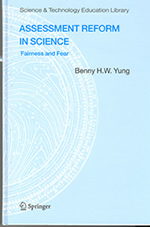Why Singapore’s English Teachers Should Embrace Singlish, Not Fight It
Is it time for Singaporean educators to embrace Singlish as a legitimate learning tool? What the Research […]
Read More
By Benny H. W. Yung (2006), Springer, ISBN 1-4020-3374-5 (HB) or ISBN 1-4020-3408-3 (e-book), 293 pp.
 An area of increasing interest in educational reform is the shift towards using assessment as a tool for improving teaching and learning. Benny Yung’s book, Assessment Reform in Science: Fairness and Fear, is a report of research findings relating to teacher professional development and science pedagogy.
An area of increasing interest in educational reform is the shift towards using assessment as a tool for improving teaching and learning. Benny Yung’s book, Assessment Reform in Science: Fairness and Fear, is a report of research findings relating to teacher professional development and science pedagogy.
Yung offers a case-driven account of how 10 teachers in Hong Kong taught and assessed A-level biology through a continuous marks-based scheme called the Teacher Assessment Scheme (TAS). Readers familiar with the Science Practical Assessment (SPA) in Singapore will see an immediate connection.
The book has 15 chapters, and includes 2 appendices which explain the theory and methods used in the study.
Following Chapters 1 and 2, which provide background information to the study, Chapter 3 portrays how the teachers implemented TAS. Using the frequency of dialogic interactions between teachers and students during the conduct of practical work as the principal unit of analysis, it was found that teachers who were more concerned with assessment issues in their laboratories tended to interact less often with their students than those teachers who were not.
In Chapters 4 to 11, eight narrative-based case studies are presented that describe teachers’ personal, educational and professional backgrounds, their stated beliefs about science practical work and pedagogy. Each case is supported with interview and lesson transcripts and includes a useful summary at the end. It is immediately noticeable that the teachers’ practices in the various case studies were markedly different.
In Chapter 12, the author shows how tensions arose when teachers were caught between the dual roles of teaching and assessing in TAS. In Chapter 13, three differing views of TAS implementation are described and analysed. It was found that the teachers’ discourses were dominated by, and their classroom actions were influenced by, their notion of fairness. They were fair in the sense of (1) assessing students on a fair basis; (2) not jeopardising students’ chances to learn the subject matter while they are being assessed; or (3) not depriving students’ of opportunities of receiving an all-round education.
For teachers to implement the new assessment scheme successfully their existing understanding and beliefs concerning assessment had to be challenged and opportunities provided for them to come to terms with the philosophy of the new assessment scheme. Most importantly, the teachers themselves had to undertake such a learning process.
Chapter 14, “Teacher Professionalism and Policy Interpretation” is perhaps the most insightful of Yung’s analyses. He revisits five of his cases to show the bases upon which his informants derived their interpretations of TAS. What emerge are threshold points in the teachers’ capacity to make discretionary judgements in their classrooms relating to assessment.
Chapter 15 recaps the research questions and presents an overview of findings in the study. Of particular interest are Yung’s views on what could be done to assist teachers in raising teachers’ professional consciousness and confidence in dealing with assessment reforms. A role is identified for continuing professional development that promotes collaboration and sustained effort.
In our opinion, this book brings across the many interpretations and realisations of the same policy change that are possible by different teachers. Meaningful learning experiences can only be formed if teachers are aware of their own beliefs and also those of others in the same profession. Awareness and comparison can lead to constructive dialogue between teachers which will lead, hopefully, to more thoughtful implementation of change.